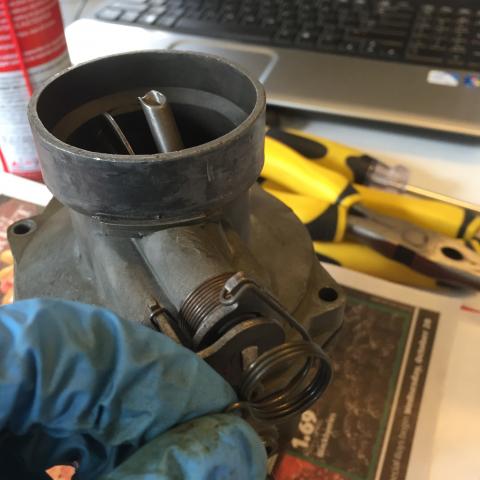Dixie: Part 3
Submitted by DamselflyDixie starts, but fills the air with dark, thick smoke.
She was built in 1959, well before the modern fuel injections system found in vehicles today. I did some research (of course, as I am an information junkie), and found that the engine is powered by mixing fuel and air, which is then burned in the metal cylinders inside the engine. The mixture of fuel and air needed by the vehicle is determined by situations like how long it has been running or how fast you are going.
The device that is in charge of maintaining the air-fuel mix is the carburetor.
The dark smoke Dixie was producing indicated the carburetor was not working well. It was allowing too much fuel in the air-fuel mix. The motor-head slang is that she was “running rich”.
Hubby suggested we buy a new carburetor.
What fun is that?
I suggested rebuilding it, and volunteered for the job. Hubby quickly conceded, as he wanted no part of that project.
I figured if I really messed it up, we could get another one. Right?
Right!
Back to the computer for more research!
I took pictures of the carburetor, and wrote down as many identifying numbers as I could find engraved on the surface. I learned Dixie is equipped with a single-barrel Rochester B carburetor. The single-barrel is the simplest model, with only one air baffle. The air cleaner sits directly on top of the barrel. A YouTube search revealed several videos that showed how to do the work. All I needed was a rebuild kit.
You can find anything on the Internet.
The videos led me to Mike’s Carburetor Parts.
Mike’s is a great site for parts and information. They offer the ability to send photos via email to help diagnose problems and assure the correct parts are ordered. I was able to find the rebuild kit I needed and an instructional DVD. Hurray!
I waited for the kit to arrive before removing the carburetor. The temperatures were still a bit chilly, so I set up my workstation in the house. I used a small table with a computer to play the DVD, a baking sheet became my work surface to capture any small pieces that slipped from my inexperienced fingers, and two plastic bins. One bin was used for old parts, and one for new parts. Some of the old parts are not part of the rebuild kit, and must be handled carefully for cleaning and reuse.
The video would say “Now, don’t lose that part”.
No pressure, right?
Right.
I started the video, pausing along the way to complete the required step of the disassemble process. The kit provided a great schematic with a blowout drawing that included all of the parts so if a part of the video was not entirely clear, I could refer to the drawing for more detail.
Once disassembled, I noted that the carburetor was fairly clean, indicating that someone had rebuilt it prior to me. Upon re-installation of the floats, I found that the prior rebuilder put them in upside down.
No wonder there was dark smoke billowing from Dixie!
The floats in the carburetor act as the fill and shut-off mechanism. In old toilets, there was a similar device. It looked like a small melon, attached to a slim post, attached to a chain, which determined when water would flow in and out of the water tank. When the float reached the top, or “full” position, the water was shut off. The carburetor float works the same way. When enough gas has come into the carburetor at any point in time, the floats move to the top of the float bowl and the gas is stopped. The floats were previously installed upside down, so there was no shut off for the fuel, thus allowing it to run with too much gas, or “rich”. Dark smoke was created as the fuel burned.
I reinstalled the carburetor, and held my breath as I started the engine.
Viola!
No more dark smoke!
My project was a simple, by mechanical standards. Completing the process does not make me an expert. It did, however, leave me smiling with great satisfaction of a job well done. I felt a sense of pride. I love a project where I can clearly see an end result. So often our task results are not so blatant, or our jobs rewarding.
Dixie needs a bit of tuning and I still have much to learn. I continue to learn the process, piece by piece.
I smile as I work. It is a labor of love.




Add new comment